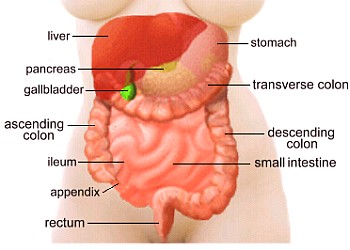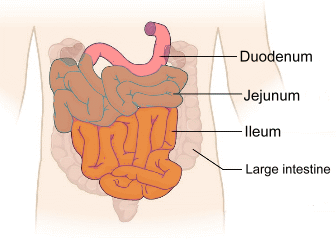  The small intestine is a coiled tubular structure that joins the stomach to the large intestine (also called the colon or bowel).
The small intestine is a coiled tubular structure that joins the stomach to the large intestine (also called the colon or bowel). The small intestine's purpose is to absorb the nutrition from food as it passes through from the stomach. It's about 7 metres long, but is only about two centimetres in diameter. Its three segments include the duodenum, jejunum and ileum.  The first portion of the small intestine, the duodenum, begins at the exit of the stomach, and curves around the pancreas to end in the region of the left upper part of the abdominal cavity, where it joins the jejunum.
The first portion of the small intestine, the duodenum, begins at the exit of the stomach, and curves around the pancreas to end in the region of the left upper part of the abdominal cavity, where it joins the jejunum. The duodenum is where the bile duct and pancreatic duct empty their contents into the small intestine to help with digestion. Below the duodeum, there is no clear delineation between the jejunum and ileum.  The lining of the small intestine is designed for the digestion and absorption of nutrients. It's highly folded to form microscopic finger-like projections called villi, which increase the surface area greatly, to help with absorption.
The lining of the small intestine is designed for the digestion and absorption of nutrients. It's highly folded to form microscopic finger-like projections called villi, which increase the surface area greatly, to help with absorption. The lining also contains specialized groups of cells that produce chemicals which help digestion, provide immune defenses, and hormones that help to control the digestive processes of the intestine, gallbladder, and pancreas. Muscular activity of the walls of the small intestine help to propel the contents through its length. The small intestine is responsible for absorption of nutrients, salt, and water. About nine litres of fluid enters the jejunum each day. The small intestine absorbs almost seven litres, leaving only 1.5 - 2 litres to enter the large intestine. The absorptive ability of the small intestine is so efficient that in a normal adult with a normal diet, over 95% of ingested carbohydrates and proteins are absorbed. The cells within the small intestine's lining can also secrete salts and water in order to maintain normal salt and water balance within the body. |